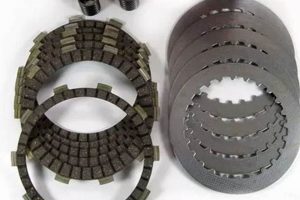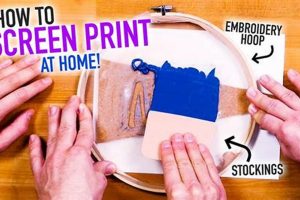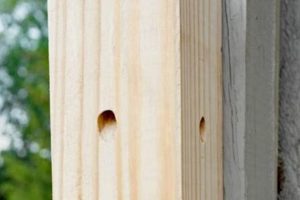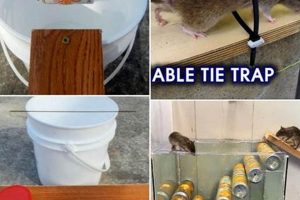The concept represents the transformation of a specific vehicle model into a compact recreational vehicle through individual modification. These alterations typically involve interior customization to provide sleeping, storage, and potentially cooking facilities within the existing vehicle footprint. The goal is often to create a self-contained mobile living space for travel and outdoor activities.
Such projects offer a cost-effective alternative to purchasing a purpose-built camper van. They also allow for personalization to meet specific needs and preferences, fostering a sense of ownership and accomplishment. Historically, this approach reflects a broader trend of adapting readily available resources for recreational purposes, driven by both economic factors and a desire for self-sufficiency.
Subsequent sections will detail the practical aspects of undertaking such a vehicle conversion, including design considerations, material selection, construction techniques, and potential challenges, providing a foundational understanding for those considering this type of endeavor.
Conversion Tips for a Honda Element into a Camper
Successfully transforming a Honda Element into a functional camper requires careful planning and execution. The following guidelines offer valuable insights for navigating this conversion process.
Tip 1: Prioritize Weight Management: The Honda Element has a limited payload capacity. Select lightweight materials for construction, such as thin plywood, aluminum framing, or durable fabrics. Minimize unnecessary additions to prevent exceeding the vehicle’s weight limits, impacting fuel efficiency and handling.
Tip 2: Optimize Spatial Efficiency: Space is at a premium. Employ multi-functional furniture designs, such as convertible beds that double as seating or storage platforms. Utilize vertical space through shelving and hanging organizers to maximize usable area.
Tip 3: Plan for Electrical Needs: A reliable power source is crucial for operating appliances and electronics. Consider a dual-battery system, solar panels, or a portable power station. Carefully calculate power consumption to ensure the chosen system adequately meets energy demands.
Tip 4: Address Ventilation and Insulation: Proper ventilation is essential to prevent condensation and maintain air quality. Install a roof vent or consider window deflectors to promote airflow. Insulation helps regulate temperature, improving comfort in varying climates. Reflectix, foam board, or spray foam are viable insulation options.
Tip 5: Secure All Components: Properly secure all modifications to the vehicle’s frame to prevent shifting during transit. Utilize appropriate fasteners, brackets, and adhesives to ensure stability and safety. Regularly inspect connections for wear and tear.
Tip 6: Adhere to Safety Standards: When modifying electrical or plumbing systems, comply with relevant safety codes. Install carbon monoxide and smoke detectors to mitigate potential hazards. Ensure adequate fire extinguishers are readily accessible.
Tip 7: Document the Process: Maintain detailed records of all modifications, including materials used, wiring diagrams, and plumbing layouts. This documentation will aid in troubleshooting and future maintenance.
Implementing these tips will facilitate a smoother, safer, and more effective Honda Element camper conversion. Thorough planning and meticulous execution are paramount to achieving a functional and enjoyable mobile living space.
Subsequent sections will address specific design considerations and detailed construction techniques, providing a comprehensive resource for potential converters.
1. Space Optimization
Space optimization within a Honda Element converted into a camper is paramount due to the vehicle’s inherent size constraints. Effective utilization of the available volume directly impacts the comfort, functionality, and overall viability of the conversion.
- Multi-Functional Furniture Design
Designing furniture to serve multiple purposes maximizes the utility of limited space. Examples include beds that convert into seating areas during the day, tables that fold away when not in use, and storage compartments integrated into structural elements. The implications extend to improved mobility within the camper and a reduced feeling of confinement.
- Vertical Space Exploitation
Utilizing vertical space through shelving, cabinets, and hanging organizers significantly increases storage capacity. These solutions leverage the often-underutilized upper regions of the vehicle, creating organized storage for clothing, gear, and other necessities. The effective use of vertical space minimizes clutter and maximizes floor area.
- Compact Appliance Integration
Selecting compact and efficient appliances is crucial for minimizing space consumption. Examples include portable refrigerators, single-burner stoves, and collapsible sinks. Integrating these appliances seamlessly into the overall design ensures functionality without sacrificing valuable living space. Careful consideration of appliance dimensions and placement is essential.
- Custom Storage Solutions
Tailoring storage solutions to specific needs and items optimizes space usage. Custom-built drawers, cubbies, and compartments can be designed to fit the exact dimensions of frequently used items, eliminating wasted space. Such bespoke solutions ensure efficient organization and easy access to essential equipment.
These facets of space optimization collectively contribute to creating a comfortable and functional living environment within the confines of a Honda Element camper conversion. Strategic design and careful execution are essential for transforming a compact vehicle into a practical and enjoyable mobile dwelling.
2. Weight Reduction
Weight reduction is a critical consideration in the conversion of a Honda Element into a camper. Exceeding the vehicle’s maximum weight capacity compromises safety, reduces fuel efficiency, and negatively impacts handling. Therefore, minimizing added weight is paramount throughout the design and construction process.
- Material Selection
The choice of building materials significantly influences the overall weight of the conversion. Opting for lightweight alternatives to traditional materials is essential. Examples include using thin plywood instead of solid wood, employing aluminum framing instead of steel, and selecting lightweight fabrics for upholstery. These substitutions directly reduce the burden on the vehicle’s suspension and powertrain.
- Component Minimization
Careful consideration of each component’s necessity and weight is crucial. Combining
functionalities into single units and eliminating non-essential items are effective strategies. For example, a multi-functional bed frame that doubles as storage eliminates the need for separate storage units, thereby reducing weight and maximizing space. Every added item should be evaluated for its contribution versus its weight penalty. - Water Management
Water storage contributes substantially to overall weight. Limiting the size of the water tank and implementing water conservation measures are vital. Utilizing lightweight water storage solutions, such as collapsible containers, can further reduce the weight burden when the tank is empty. Precise management of water usage is a crucial aspect of weight reduction.
- Unnecessary Items
Avoiding unnecessary modifications and accessories is a direct way to manage weight. Large and elaborate carpentry adds additional weight. Focus on essential functions and keep design simple. Consider carefully before adding any non-essential item.
In summary, weight reduction is an inextricable component of a successful Honda Element camper conversion. Through judicious material selection, component minimization, responsible water management, and the avoidance of non-essential items, it is possible to create a functional and enjoyable camper without compromising safety or performance.
3. Power Solutions for the DIY Honda Element Camper
Electrical power is a fundamental requirement for the functionality of a Honda Element converted into a camper. Modifications transforming the vehicle into a livable space often necessitate power for lighting, refrigeration, device charging, and potentially for operating small appliances. Without a reliable and appropriately sized power system, the utility of the converted camper is significantly diminished, rendering it less practical for extended trips and off-grid use.
Several power solutions are commonly implemented in these DIY conversions. A prevalent method involves installing a dual-battery system, isolating a secondary battery for camper-specific electrical loads from the vehicle’s starting battery, preventing potential discharge that could strand the vehicle. Solar panels are frequently integrated to provide a renewable energy source for charging the auxiliary battery, reducing reliance on external power sources. Portable power stations, offering pre-packaged battery and inverter solutions, represent another option, albeit potentially at a higher initial cost. The selection of a specific power solution is contingent upon individual energy needs, budget constraints, and the desired level of self-sufficiency.
Ultimately, the choice and proper implementation of power solutions are critical determinants of the success of a Honda Element camper conversion. Ensuring adequate capacity, safe wiring practices, and appropriate protection measures are paramount to a functional and enjoyable camper experience. Disregard for these considerations can lead to system failures, safety hazards, and a significant reduction in the vehicle’s overall usability as a mobile living space. Subsequent discussions will address specific wiring techniques and safety protocols.
4. Ventilation strategy
The conversion of a Honda Element into a camper necessitates careful consideration of ventilation strategies. The confined space of the vehicle, when occupied for sleeping or cooking, accumulates moisture and potentially hazardous gases. Inadequate ventilation leads to condensation, creating conditions conducive to mold growth and compromising air quality. This poses health risks to occupants and accelerates the deterioration of interior materials. A well-designed ventilation system is therefore not merely a comfort feature but a critical safety component of any successful DIY Honda Element camper conversion.
Effective ventilation strategies for a Honda Element camper typically involve a combination of passive and active methods. Passive ventilation relies on natural airflow through strategically placed vents and window openings. Window deflectors allow windows to remain slightly open even during inclement weather, promoting continuous air exchange. Active ventilation systems, such as roof-mounted fans, force air circulation, drawing stale air out of the vehicle and introducing fresh air. The sizing and placement of vents and fans are crucial for maximizing airflow and minimizing stagnant areas within the camper. Real-world examples demonstrate the detrimental effects of neglecting ventilation: corroded metal components, fogged windows, and musty odors are common indicators of insufficient airflow. Conversely, well-ventilated conversions exhibit improved air quality, reduced humidity, and a more comfortable living environment.
In conclusion, a robust ventilation strategy is integral to the success and safety of a DIY Honda Element camper. Addressing moisture build-up and ensuring fresh air circulation is a prerequisite for healthy living space. Without it, camper conversions are prone to issues that can quickly compromise the enjoyment and longevity of the project. This aspect warrants careful planning and execution during the conversion process.
5. Structural Integrity
The conversion of a Honda Element into a camper necessitates modifications that can potentially compromise the vehicle’s original structural integrity. Additions like roof racks, solar panel mounts, or internal support structures, if improperly installed, introduce stress points and alter weight distribution. Such alterations, without adequate reinforcement, can lead to metal fatigue, weld failures, and ultimately, a reduction in the vehicle’s overall safety and lifespan. Consequently, meticulous attention to structural reinforcement and load management is paramount during the conversion process.
Examples of compromised structural integrity in DIY camper conversions range from minor inconveniences to catastrophic failures. Sagging roofs due to inadequate support for solar panels or water tanks, cracks in the vehicle’s frame near modified attachment points, and deformation of body panels due to uneven weight distribution are all indicative of underlying structural weaknesses. In extreme cases, poorly executed modifications can even contribute to accidents by altering the vehicle’s handling characteristics or compromising its crashworthiness. Proper welding techniques, reinforcement plates, and adherence to established engineering principles are crucial for mitigating these risks. Failure to address these considerations can lead to costly repairs, unsafe travel conditions, and a diminished resale value of the vehicle.
In summary, preserving the structural integrity of a Honda Element during a camper conversion is not merely a matter of aesthetics or convenience but a fundamental safety concern. Sound engineering principles, appropriate materials, and diligent craftsmanship are essential for ensuring the longevity and safety of the vehicle. Neglecting this aspect of the conversion introduces significant risks that far outweigh any potential cost savings or shortcuts taken during the construction process. The commitment to structural
integrity should remain a central tenet of any successful DIY camper conversion project.
Frequently Asked Questions
This section addresses common inquiries regarding the transformation of a Honda Element into a recreational vehicle, providing clarity on key aspects of the conversion process.
Question 1: Does converting a Honda Element into a camper void the factory warranty?
Modifications to a vehicle can affect the manufacturer’s warranty coverage. Specifically, any damage or failure directly attributable to the conversion will likely not be covered. The original factory warranty remains applicable to components and systems unaffected by the alterations.
Question 2: Is professional assistance required for electrical system modifications?
While not strictly mandated, engaging a qualified electrician for electrical work is strongly advised. Improper wiring poses significant safety risks, including fire hazards and equipment damage. Compliance with relevant electrical codes is essential.
Question 3: What are the legal considerations regarding modifications to the vehicle’s structure?
Modifications to the vehicle’s frame or chassis may be subject to state and local regulations. Consult relevant transportation authorities regarding inspection requirements and potential restrictions on structural alterations.
Question 4: Is it possible to revert the vehicle back to its original configuration after the conversion?
Reversibility depends on the nature and extent of the modifications. Non-destructive alterations, such as removable furniture and modular electrical systems, facilitate easier reversion. Permanent modifications, however, may require significant effort and expense to undo.
Question 5: What is the estimated cost associated with a DIY Honda Element camper conversion?
The total cost varies widely depending on the complexity of the project, materials used, and the extent of professional services engaged. A basic conversion can range from several hundred to several thousand dollars. Comprehensive planning and budgeting are crucial for cost management.
Question 6: What type of insurance coverage is appropriate for a converted Honda Element camper?
Standard auto insurance may not adequately cover the value of the modifications. Consult an insurance provider to discuss specialized coverage options that account for the added value of the camper conversion. Documenting all modifications with photographs and receipts is recommended.
In conclusion, the decision to undertake a DIY Honda Element camper conversion requires careful consideration of various factors, including warranty implications, safety concerns, legal requirements, and financial aspects. Thorough research and meticulous planning are essential for a successful outcome.
The subsequent section will delve into case studies of successful conversions, providing practical examples and inspiration for potential converters.
Conclusion
This exploration of “diy honda element e camper” conversions has highlighted crucial considerations for individuals contemplating such a project. It’s been shown that successful execution necessitates meticulous planning, a thorough understanding of structural and electrical systems, adherence to safety protocols, and careful cost management. The feasibility of these conversions hinges upon a balance between individual customization and the preservation of the vehicle’s original functionality and integrity.
The transformative potential of modifying a Honda Element into a camper represents a significant undertaking. While the rewards of a personalized and cost-effective recreational vehicle are substantial, the challenges demand a serious commitment to safety, structural soundness, and legal compliance. Prospective converters are encouraged to approach the project with diligence and a focus on sustainable practices to ensure a long-lasting and responsible outcome.







